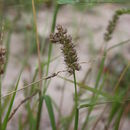Global Distribution
provided by Bibliotheca Alexandrina LifeDesk
Native to tropical Africa, Arabia, eastwards to India.
- author
- BA Cultnat
- provider
- Bibliotheca Alexandrina
Habitat
provided by Bibliotheca Alexandrina LifeDesk
Introduced weed, naturalized in newly reclaimed lands east and west of the Nile Delta.
- author
- BA Cultnat
- provider
- Bibliotheca Alexandrina
Description
provided by eFloras
Annual; culms 5-90 cm high, ascending. Leaf-blades 2-25 cm long, 2-7 mm. wide. Panicle 2-15 cm long; involucres ovoid, 4-11 mm long; inner spines flattened, connate at the base to form an ovoid or diamond-shaped disc 2-4 mm across, bearing 1-3 shallow grooves on the outer face, ciliate below, retrorsely barbellate and mostly pungent at the tip; outer spines numerous, acicular, shorter than the inner, commonly divergent, rarely suppressed. Spikelets 1-3 per burr, 3.5-6 mm long.
- license
- cc-by-nc-sa-3.0
- copyright
- Missouri Botanical Garden, 4344 Shaw Boulevard, St. Louis, MO, 63110 USA
Distribution
provided by eFloras
Distribution: Pakistan (Sind, Punjab & Kashmir); tropical Africa, extending through Arabia to India.
- license
- cc-by-nc-sa-3.0
- copyright
- Missouri Botanical Garden, 4344 Shaw Boulevard, St. Louis, MO, 63110 USA
Derivation of specific name
provided by Flora of Zimbabwe
biflorus: 2-flowered
- license
- cc-by-nc
- copyright
- Mark Hyde, Bart Wursten and Petra Ballings
- bibliographic citation
- Hyde, M.A., Wursten, B.T. and Ballings, P. (2002-2014). Cenchrus biflorus Roxb. Flora of Zimbabwe website. Accessed 28 August 2014 at http://www.zimbabweflora.co.zw/speciesdata/species.php?species_id=107910
- author
- Mark Hyde
- author
- Bart Wursten
- author
- Petra Ballings
Physical Description
provided by USDA PLANTS text
Annuals, Terrestrial, not aquatic, Stems nodes swollen or brittle, Stems erect or ascending, Stems geniculate, decumbent, or lax, sometimes rooting at nodes, Stems caespitose, tufted, or clustered, Stems terete, round in cross section, or polygonal, Stems branching above base or distally at nodes, Stem internodes solid or spongy, Stems with inflorescence less than 1 m tall, Stems, culms, or scapes exceeding basal leaves, Leaves mostly cauline, Leaves conspicuously 2-ranked, distichous, Leaves sheathing at base, Leaf sheath mostly open, or loose, Leaf sheath smooth, glabrous, Leaf sheath hairy, hispid or prickly, Leaf sheath hairy at summit, throat, or collar, Leaf sheath or blade keeled, Leaf sheath and blade differentiated, Leaf blades linear, Leaf blades lanceolate, Leaf blades 2-10 mm wide, Leaf blades mostly flat, Leaf blades mostly glabrous, Leaf blades more or less hairy, Leaf blades scabrous, roughened, or wrinkled, Ligule present, Ligule a fringe of hairs, Inflorescence terminal, Inflorescence a dense slender spike-like panicle or raceme, branches contracted, Inflorescence solitary, with 1 spike, fascicle, glomerule, head, or cluster per stem or culm, Flowers bisexual, Spikelets sessile or subsessile, Spikelets dorsally compressed or terete, Spikelet 3-10 mm wide, Spikelets with 1 fertile floret, Spikelets with 2 florets, Spikelet with 1 fer tile floret and 1-2 sterile florets, Spikelets solitary at rachis nodes, Spikelets 1-4 in short bristly fascicles, Spikelets all alike and fertille, Spikelets bisexual, Spikelets disarticulating below the glumes, Spikelets falling with parts of disarticulating rachis or pedicel, Spikelets in bur-like clusters or fascicles with fused bracts, bristles or spines, Spikelet bristles fused together, Spikelets all subtended by bristles, Spikelet bristles 4-many, Spikelet bracts or bristles disarticulating with spikelet, Spikelets in dense head-like clusters, Rachilla or pedicel glabrous, Pistillate spikelet enclosed in hard bony involucre, Glumes present, empty bracts, Glumes 2 clearly present, Glumes distinctly unequal, Glumes shorter than adjacent lemma, Glumes equal to or longer than adjacent lemma, Glume equal to or longer than spikelet, Glumes 1 nerved, Glumes 3 nerved, Glumes 4-7 nerved, Lemma similar in texture to glumes, Lemma coriaceous, firmer or thicker in texture than t he glumes, Lemma 3 nerved, Lemma 5-7 nerved, Lemma glabrous, Lemma apex acute or acuminate, Lemma awnless, Lemma straight, Palea present, well developed, Palea membranous, hyaline, Palea about equal to lemma, Stamens 3, Styles 2-fid, deeply 2-branched, Stigmas 2, Fruit - caryopsis, Caryopsis isodiametric, trigonous or globose, broadest at base or beaked.
Cenchrus biflorus: Brief Summary
provided by wikipedia EN
Cenchrus biflorus is a species of annual grass in the family Poaceae. Common names include Indian sandbur, Bhurat or Bhurut in India, Haskaneet in Sudan, Aneeti in the Arabic dialect of Mauritania, K 'arangiya in the Hausa language of Nigeria, and Ngibbi in the Kanuri language of Nigeria. In the francophone countries of the Sahel, it is usually referred to as "cram-cram" .
- license
- cc-by-sa-3.0
- copyright
- Wikipedia authors and editors

